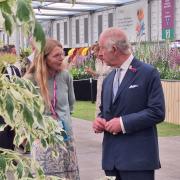Arriving at James Alexander-Sinclair’s Cotswold home, I’m greeted by the familiar gardeners’ cry ‘You should have been here last week.’
It seems the dazzling display from ‘Orange Emperor’ tulips is past its best and it’s too early for the herbaceous to be contributing much. Even so, there’s still colour from snake’s head fritillaries tucked into one corner, a Magnolia x soulangeana ‘Lennei Alba’ sporting goblet-shaped blooms and other tulips that have taken over from the fading emperors.

James is well-known in the horticultural world. A member of the Royal Horticultural Society’s council for 10 years, he’s currently an RHS vice-president, their Ambassador for Garden Design, a gardens judge, gardens advisor at RHS Hyde Hall in Essex and a recipient of the RHS Veitch Memorial Medal, awarded for an outstanding contribution to horticulture.
‘I love the RHS,’ he says. ‘They’re a fabulous organisation who do an enormous amount of good work in many different areas and I try to help where I can.’

For Cotswold gardeners, he’s probably most familiar as a host at the RHS Malvern Spring Festival where he leads discussions on everything plants and gardens.
All this is combined with a successful design practice that sees him creating gardens across the country, including two at Chelsea, writing, and lecturing.
His own garden was started eight years ago when he and his wife, Celestria, relocated from Northamptonshire.

‘Obviously, it’s a work in progress because all gardens are,’ he says. Partly, this is because he’s always wanting to try something new, something exciting.
‘You can plan other people's gardens quite easily but with your own garden you look at it so much and for so much of the time that you change your mind all the time.’
It was the potential that attracted him to the Oxfordshire plot of just under half an acre after creating a garden from a bare farmyard at his previous home.

‘It had a lot of things that I didn’t have before, which is always an attraction,’ he explains. ‘This garden was full of trees and quite big shrubbery.’
Even so, he began by taking things out, namely a long line of laurel, which although it gave privacy from their neighbours, was deemed boring.
Instead, he’s been planting what he considers to be more interesting trees and shrubs, among them a yellow magnolia whose later blooming means it usually escapes frost-damage, a podocarpus, or Japanese conifer, Sycopsis sinensis, which has unusual red flowers in winter, and the white Ribes laurifolium ‘Mrs Amy Doncaster’.
‘It's going to take 10 to 15 years to get that level of privacy back again, but the plants that are doing it will be nicer.
‘There are lots of interesting and exciting things to entertain me.’
Some, notably an Indian chestnut, haven’t worked – ‘It’s just a really messy tree and I don’t like it, so it’s coming out.’

It’s a lesson James believes all gardeners need to learn: ‘You have to be discerning and if something isn’t working, or doesn’t make you happy, or doesn’t make you smile or doesn’t give you joy, then you have to get rid of it.’
Not buying everything you see and like is also important: ‘Most people garden on a relatively small scale, which means you can’t grow everything. You can walk around Malvern and find goodness knows how many plants but if you brought all of them home, you’d be stuffed.’
Alongside the house, silver birch and a plum that they inherited give much-need shade to the south-facing terrace. There are pots of succulents, and seasonal colour, including tulips, while outside James’ study is a small gravel garden that has just been cleared of spreading Japanese anemones and self-sown Seseli libanotis, and replanted with iris.

‘I think gravel works well with most plants,’ he observes.
Vegetables are Celestria’s domain and are grown in raised beds and a greenhouse in a small kitchen garden that is also home to chickens.
The centre of the garden has a curious ‘mound’ created mostly out of rubble from alterations to the house. It’s planted with a mix of trees, including paulownia that are coppiced hard each year to promote large leaves, shrubs, such as tetrapanax, and Calycanthus ‘Aphrodite’, and herbaceous. It has a path allowing you to reach the top with steps at the other end a future project.

‘It creates different heights and gives a contour to the garden,’ comments James. ‘The mound is there to absorb the rubble, to have somewhere interesting to plant on and to hide the surprise.’
That surprise is a pond with rocks recycled from Cleve West’s 2016 Chelsea show garden, rocks that came originally from the Forest of Dean.

This early in the season, it’s marsh marigolds that are taking centre stage along with lovely reflections from the bare branches of nearby shrubs and trees.
The end of the garden is devoted to making compost and leaf mould – ‘All the things that gardeners understand and casual gardeners don’t really appreciate.’
Gardening has changed since James ‘fell into garden design by accident’ having worked as a landscape contractor.
‘Gardens are no longer just for people,’ he observes. ‘Its about the whole ecosystem in the world.’

So, while he can never envisage being without lawn, he is anticipating more of what he describes as ‘shaggy bits’ in the garden.
This awareness of gardening’s place in the wider landscape has driven many changes at RHS shows, not least the need now for gardens to have an after-show life and more of an emphasis on the carbon footprint of each design.
He’s looking forward to Malvern, which is the first big outdoor gardening show of the season.
‘It’s always exciting to have a stonking Malvern to begin with and then we carry on from there.
‘Our job there is to is to fill people with enthusiasm for horticulture and send them back to their gardens with vim and pep.’
Instagram: @thechattygardener
Facebook: The Chatty Gardener
X: @ChattyGardener

Gardening for Change at RHS Malvern Spring Festival
A celebration of houseplants, a kitchen garden theatre and an immersive garden by an award-winning designer are among the new features at this year’s RHS Malvern Spring Festival.
The Festival of Houseplants will be staged in the newly constructed Kildare Hall at the Three Counties Showground. Run as a collaboration with Green Rooms Market, it will have displays by leading houseplant firms, and workshops and advice from experts. Among the special guests will be Joe Bagley, The Houseplant Doctor, Ben Newell from Worcester Terrariums, and Jonny Balchandani, The Bearded Plantaholic.
Grow your own enthusiasts will get advice on cooking with homegrown ingredients from chefs and local food producers with the audience sitting in the midst of a kitchen garden, designed by Stonebarn Landscapes.
If that works up an appetite, garden sheds have been repurposed into luxury secluded dining spaces with beautiful views over the Malvern Hills. They will be serving everything from breakfast and afternoon tea to lunch with pre-booking essential.
The theme for this year’s festival is ‘Gardening for Change’ and several of the show gardens have recycling at their heart.
‘It Doesn’t Have to Cost the Earth’, designed by Michael Lote uses sustainable construction methods and reclaimed materials to create a wildlife friendly space.
‘Concrete 2.0’, by Ian McBain, showcases sustainable paving that’s been produced in the UK using cement-free concrete and recycled aggregates along with other reclaimed materials.
Award-winning designers Graduate Gardeners return to the festival for the first time since 2018 with a garden for entertaining that is inspired by the Cotswolds. It will feature a natural stream running through the garden and into a meadow.
Other show gardens include one based on Sir Roy Strong’s garden, The Laskett, while others will highlight the work of Macmillan Cancer Support, and The Grand Appeal, the Bristol Royal Hospital for Children’s charity.
Jamie Langlands, who won Gold, Best in Show, Best Construction and the People’s Choice awards at last year’s festival, is creating an immersive feature garden designed to be an oasis in the heart of the festival.
‘The Secret Escape’ will be accessed via a disco polytunnel filled with greenery and a kaleidoscopic disco ball.
At the heart of the garden, there will be a weathered boat, used as a platform for live performances, while a horse box will be converted into a bar.
Surrounding the garden, is a wilder area of native plants and hedgerow planting that will create a natural boundary from the rest of the festival.
Meanwhile, regular features include the Floral Marquee with some of the country’s top nurseries, the Festival Theatre with guest speakers, and stands from leading horticultural sundries firms.
The show runs from Thursday May 9 to Sunday May 12 with a new ‘Taster Ticket’ that gives entry from 2pm on the Saturday for just £15. More information and booking is on the website rhsmalvern.co.uk



























